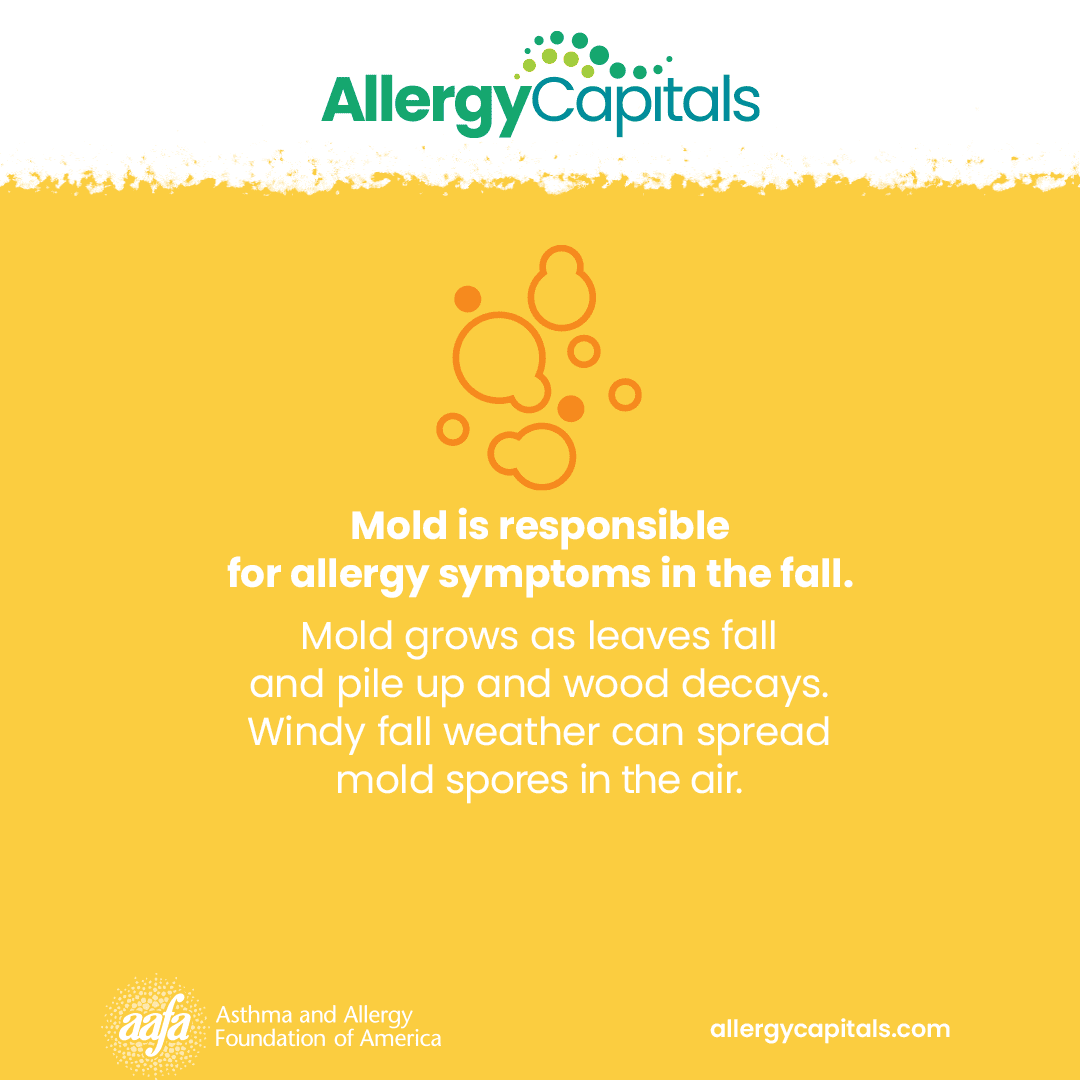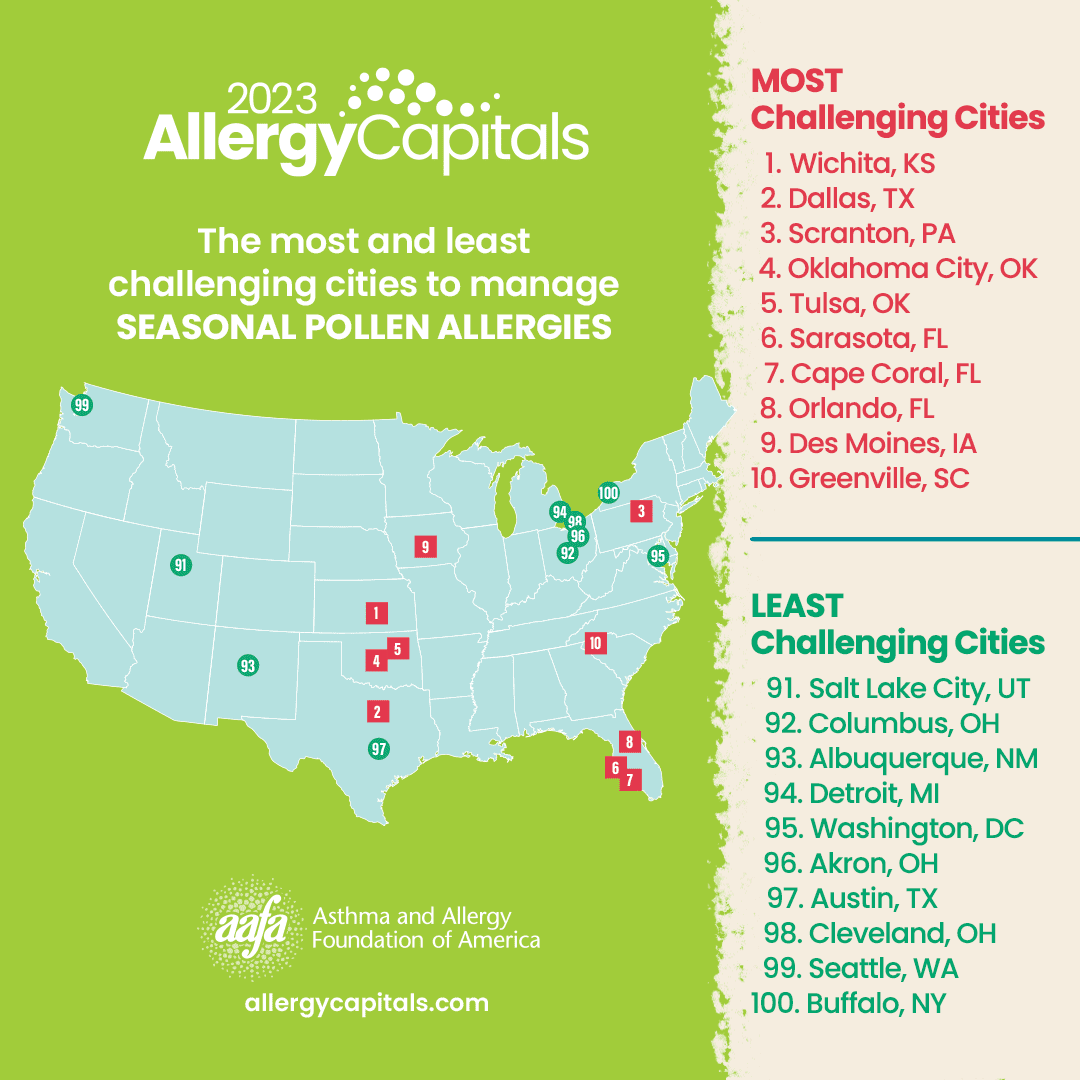Ah, fall! Time for cozy jackets, colorful leaves, pumpkin spice lattes, and … allergy medicine? If you’ve noticed the change in season also triggers allergy and asthma symptoms, you’re not alone. Just like spring, fall is a time when many people are seeking relief from their seasonal allergies.
Common symptoms of seasonal allergies include:
- Itching in the nose and eyes
- Sneezing
- Stuffy nose (congestion)
- Runny nose
- Mucus (phlegm) in the throat (postnasal drip)
Do You Live in an Allergy Capital™?
Your location can have an impact on your seasonal allergies. Our 2023 Allergy Capitals™ report looks at the top 100 most challenging cities in the continental United States to live with seasonal pollen allergies.
The Asthma and Allergy Foundation of America (AAFA) has produced this report to:
- Help people recognize, prevent, and manage allergy symptoms
- Help communities identify where the needs of people with allergic diseases can be better met
- Raise awareness about the impact of seasonal allergies and provide helpful information to improve the quality of life for people who experience them
Relief from seasonal allergies is possible with the right treatment no matter where you live.
Weed Pollen
Weed pollen is one of the main causes of allergy symptoms – especially the ragweed. Ragweed pollen allergy affects about 15% of Americans.
Ragweed is hard to escape from in the United States. It grows in 49 states. There are several types. And ragweed’s pollen is so light, it can travel for hundreds of miles in the air.
Ragweed season starts around July or August, depending on what state you live in. Then it peaks in mid-September. And in some parts of the country, ragweed sticks around until November.
But ragweed isn't the only type of plant that can cause fall allergy symptoms. Other types of weeds that can cause symptoms include:
- Burning bush
- Cocklebur
- Lamb’s-quarters
- Mugwort
- Pigweed
- Russian thistle
- Sagebrush
- Tumbleweed

Tips for Dealing with a Weed Pollen Allergy
- Try to keep weed pollen out of your home by changing clothes and washing them after you spend time outside. Cover your hair when you go outside or wash it at night to remove pollen. And leave those shoes by the door.
- Keep your windows and doors closed, if possible. Use your central air conditioning system, if you have one. You may be tempted to open up your home to let the cool fall air in. But it can let pollen in as well.
- Wear a mask and sunglasses to reduce your pollen exposure. The mask you wear to help prevent the spread of the coronavirus that causes COVID-19 can also keep pollen from getting into your nose and lungs. So wearing a mask can have multiple benefits.
- If you do have a central air conditioning system, use air filters that are CERTIFIED asthma & allergy friendly® and change them according to the manufacturer's directions.
Nasal Spray Tip
A nasal spray is one type of treatment recommended to treat pollen allergies. Many are available over the counter. To make sure your nasal steroid spray is effective in treating nasal allergy symptoms, follow these steps:
- Gently blow your nose before using the spray.
- Don’t tip your head backwards.
- Place the tip at the entrance of your nostril and aim it toward the ear on the same side.
- Use your finger to hold the other nostril closed.
Mold
Mold counts tend to be higher in the fall. Fall landscapes can encourage mold growth. As leaves fall and wood decays, mold thrives. Dry, breezy fall weather can spread mold spores in the air. But fall can also be warm and humid in some places. That encourages mold growth too.
You can also find mold inside your home. It is often found in bathrooms, kitchens, and basements. It can appear any time of year, especially if you have a water leak or live in a humid climate.
Mold allergy symptoms are the same as typical seasonal allergy symptoms. But an allergy to a type of mold called aspergillus can cause allergic bronchopulmonary aspergillosis. It is severe and can be hard to treat. Symptoms may include severe wheezing, coughing, and shortness of breath, much like asthma.

Tips for Dealing with a Mold Allergy
- Clean up fall leaves and yard debris as soon as possible to avoid giving mold a place to thrive. Wear an N-95 mask when cleaning up moldy areas, working with mulch, or cleaning up rotting logs and wood. Or have someone without a mold allergy do it, if possible.
- Wear sunglasses, a face mask, and a hat when outside.
- Fix and remove sources of mold in your home. Repair water leaks right away. Use exhaust fans in your kitchen and bathroom. Don’t leave wet towels and clothing sitting around.
- Use a dehumidifier to remove moisture in your home. Keep humidity below 45%.
Understanding the Difference Between COVID-19 and Seasonal Allergy Symptoms
Some symptoms of COVID-19 can be similar to seasonal allergy symptoms, as well as other respiratory infections. AAFA has created this chart to help you understand the different symptoms of COVID-19, the flu, the common cold, asthma, and allergies. If you have a fever and any of these symptoms, talk with your doctor.
Warmer Weather and Longer, Stronger Growing Seasons
If you think fall is starting to feel more like summer, you’re right. Climate change is responsible for a longer, warmer growing fall season, giving plants more time to grow and produce more pollen.
Since 1970, most major U.S. cities have seen an increase in fall temperatures. Warmer fall seasons mean plants, like ragweed, grow and produce pollen longer.1 Pollen growing seasons have gotten two weeks longer on average. And if that's not bad enough, more carbon dioxide emissions can create more potent pollen.2
Tips to Deal with Allergies and Climate Change
- Track pollen and mold readings often. Check sites like AAAAI's National Allergy Bureau for pollen and mold counts. Plan your activities when counts are lower.
- Talk to your allergist about allergy treatment. Allergies can be managed with treatments such as antihistamines, nasal sprays and immunotherapy (allergy shots). Relief is possible with the right management plan.
- Contact your lawmakers about climate change. Sign up for AAFA's Advocacy Action Alerts to learn about opportunities to contact legislators on bills that can reduce carbon emissions and fight climate change.
It is important to stay up-to-date on news about asthma and allergies. By joining our community and following our blog, you will receive tips about managing your health. Our community also provides an opportunity to connect with other patients who manage these conditions for support.




Comments (2)